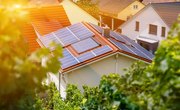
Solar energy provides power without producing greenhouse gases for your home or business, and is a completely renewable source of energy. The cost of making power from sunlight has been steadily decreasing, leading to many uses that affect you in your daily life. Solar batteries provide electric power outdoors, on your desktop and in the depths of space. Electricity from solar plants supplies commercial-grade power, reducing dependence on coal and natural gas.
TL;DR (Too Long; Didn't Read)
TL;DR
Solar energy from photovoltaic cells is used for commercial power generation, road signs, calculators, satellites and in many other applications. Rooftop collectors use solar power to directly heat water without converting it to electricity first.
Commercial Power Generation
A growing number of large solar installations generate power that augments electricity from conventional nuclear and fossil fuel power plants. For example, the Ivanpah solar power plant produces an estimated 377 megawatts of energy -- enough to supply the theoretical energy needs of 144,000 homes. In the United States alone, solar-based power plants accounted for 880 gigawatt-hours of electricity as of June 2013, an increase of 57 percent over the same period in 2012.
Road Signs
Small-scale solar power for lighting and other uses avoids the need for gas-powered generators or wiring to an electrical outlet. A small solar panel provides enough power to light up a the stop signs or message boards used in construction work. Other types of solar-powered signs include speed limit signs and radar-driven speed warnings. The solar panel charges a battery so the sign continues to light up during nighttime hours.
Hot Water
Solar rooftop collectors use heat gathered from sunlight for hot water and building heat. These solar installations do not convert light into electricity; they use the sun’s heat to increase the temperature of water or another fluid flowing through pipes in the collector. The building then uses the hot water for swimming pools, showers, laundry and other applications. In many cases, the heating system has a traditional gas or electric utility connection that heats the water in case of prolonged cold temperatures or cloudy weather.
Satellites in Orbit
In space, without clouds or air to reduce sunlight, 1,300 watts of energy per square meter arrives from the sun. Satellites use solar cells to convert sunlight into electrical energy, powering sophisticated on-board radio and computer equipment and affecting your daily life through satellite radio, television and weather forecasting. Because they are expensive to launch, operate hundreds of miles above the Earth and are very difficult to maintain, satellites need a reliable source of power. Photovoltaic cells provide it for up to 20 years.
Pocket Calculators
Some desktop and pocket calculators have miniature solar panels built into them, providing energy to run the electronics inside. The solar panel runs on both sunlight and artificial lighting, such as incandescent and fluorescent bulbs. Solar-powered calculators typically have a “button” battery in addition to the solar panel, allowing their use in dimly-lit settings.
References
About the Author
Chicago native John Papiewski has a physics degree and has been writing since 1991. He has contributed to "Foresight Update," a nanotechnology newsletter from the Foresight Institute. He also contributed to the book, "Nanotechnology: Molecular Speculations on Global Abundance." Please, no workplace calls/emails!
